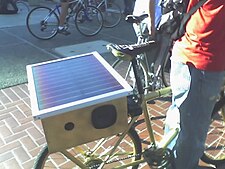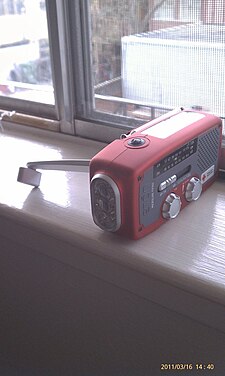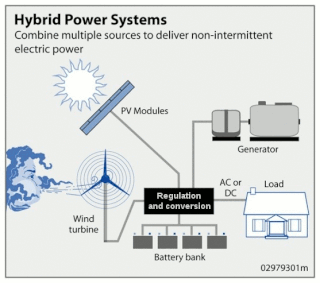


A solar powered radio is a portable radio receiver powered by photovoltaic panels. [1] It is primarily used in remote areas where access to power sources is limited.



A solar powered radio is a portable radio receiver powered by photovoltaic panels. [1] It is primarily used in remote areas where access to power sources is limited.
The solar powered radio first came into existence in the 1950s. An experimental model, developed by General Electric, weighed just 10 ounces and was capable of working without light and recharging. It contained seven solar cells, four transistors and a small battery. [2] [3] In 1954, Western Electric began to sell commercial licenses solar powered radio, including other photovoltaic technologies. [4] In 1957 the Acopian Technical Co. of Pohatcong Township, New Jersey, was reported as manufacturing the first solar radios for commercial sale to the general public. [5]
Solar powered radios eliminate the need to replace batteries, which makes operating them cost much less. Since they don't require plugs, they can be used in areas where there is no electrical grid or generators. [6] As a result, people in remote areas with little disposable income can have equal access to news and information. Informative radio programs on human rights, women’s rights, the importance of education (especially for girls), HIV and AIDS, animal husbandry, agriculture, food security, combined with solar powered radios, can be a powerful tool for improving the lives of people in remote areas. [7]

Electricity generation is the process of generating electric power from sources of primary energy. For utilities in the electric power industry, it is the stage prior to its delivery to end users or its storage.
Distributed generation, also distributed energy, on-site generation (OSG), or district/decentralized energy, is electrical generation and storage performed by a variety of small, grid-connected or distribution system-connected devices referred to as distributed energy resources (DER).

Photovoltaics (PV) is the conversion of light into electricity using semiconducting materials that exhibit the photovoltaic effect, a phenomenon studied in physics, photochemistry, and electrochemistry. The photovoltaic effect is commercially utilized for electricity generation and as photosensors.

A solar inverter or PV inverter, is a type of electrical converter which converts the variable direct current (DC) output of a photovoltaic (PV) solar panel into a utility frequency alternating current (AC) that can be fed into a commercial electrical grid or used by a local, off-grid electrical network. It is a critical balance of system (BOS)–component in a photovoltaic system, allowing the use of ordinary AC-powered equipment. Solar power inverters have special functions adapted for use with photovoltaic arrays, including maximum power point tracking and anti-islanding protection.

A solar vehicle or solar electric vehicle is an electric vehicle powered completely or significantly by direct solar energy. Usually, photovoltaic (PV) cells contained in solar panels convert the sun's energy directly into electric energy. The term "solar vehicle" usually implies that solar energy is used to power all or part of a vehicle's propulsion. Solar power may be also used to provide power for communications or controls or other auxiliary functions.

A stand-alone power system, also known as remote area power supply (RAPS), is an off-the-grid electricity system for locations that are not fitted with an electricity distribution system. Typical SAPS include one or more methods of electricity generation, energy storage, and regulation.
BP Solar was a manufacturer and installer of photovoltaic solar cells headquartered in Madrid, Spain, with production facilities in India and the People's Republic of China. It was a subsidiary of BP.

Solar power represented a very small part of electricity production in the United Kingdom (UK) until the 2010s when it increased rapidly, thanks to feed-in tariff (FIT) subsidies and the falling cost of photovoltaic (PV) panels.
A charge controller, charge regulator or battery regulator limits the rate at which electric current is added to or drawn from electric batteries. It prevents overcharging and may protect against overvoltage, which can reduce battery performance or lifespan and may pose a safety risk. It may also prevent completely draining a battery, or perform controlled discharges, depending on the battery technology, to protect battery life. The terms "charge controller" or "charge regulator" may refer to either a stand-alone device, or to control circuitry integrated within a battery pack, battery-powered device, or battery charger.

Solar power is the conversion of energy from sunlight into electricity, either directly using photovoltaics (PV), indirectly using concentrated solar power, or a combination. Concentrated solar power systems use lenses or mirrors and solar tracking systems to focus a large area of sunlight into a small beam. Photovoltaic cells convert light into an electric current using the photovoltaic effect.

A solar car is a solar vehicle used for land transport. Solar cars usually run on only power from the sun, although some models will supplement that power using a battery, or use solar panels to recharge batteries or run auxiliary systems for a car that mainly uses battery power.

A photovoltaic system, also PV system or solar power system, is a power system designed to supply usable solar power by means of photovoltaics. It consists of an arrangement of several components, including solar panels to absorb and convert sunlight into electricity, a solar inverter to convert the output from direct to alternating current, as well as mounting, cabling, and other electrical accessories to set up a working system. It may also use a solar tracking system to improve the system's overall performance and include an integrated battery solution, as prices for storage devices are expected to decline. Strictly speaking, a solar array only encompasses the ensemble of solar panels, the visible part of the PV system, and does not include all the other hardware, often summarized as balance of system (BOS). As PV systems convert light directly into electricity, they are not to be confused with other solar technologies, such as concentrated solar power or solar thermal, used for heating and cooling.

A solar lamp also known as solar light or solar lantern, is a lighting system composed of a LED lamp, solar panels, battery, charge controller and there may also be an inverter. The lamp operates on electricity from batteries, charged through the use of solar photovoltaic panel.

Solar power in Arizona has the potential to, according to then-Governor Janet Napolitano, make Arizona "the Persian Gulf of solar energy". In 2012, Arizona had 1,106 MW of photovoltaic (PV) solar power systems, and 6 MW of concentrated solar power (CSP), bringing the total to over 1,112 megawatts (MW) of solar power. The Solana Generating Station is a 280 MW parabolic trough solar plant which is the largest plant of its type in the world. Solana includes 6 hours of power storage by molten salt. The plant will provide 5% of the power from Arizona Public Service, the state's largest utility.

The energy sector in Hawaii has rapidly adopted solar power due to the high costs of electricity, and good solar resources, and has one of the highest per capita rates of solar power in the United States. Hawaii's imported energy costs, mostly for imported petroleum and coal, are three to four times higher than the mainland, so Hawaii has motivation to become one of the highest users of solar energy. Hawaii was the first state in the United States to reach grid parity for photovoltaics. Its tropical location provides abundant ambient energy.

A rooftop photovoltaic power station, or rooftop PV system, is a photovoltaic (PV) system that has its electricity-generating solar panels mounted on the rooftop of a residential or commercial building or structure. The various components of such a system include photovoltaic modules, mounting systems, cables, solar inverters and other electrical accessories.

A grid-connected photovoltaic system, or grid-connected PV system is an electricity generating solar PV power system that is connected to the utility grid. A grid-connected PV system consists of solar panels, one or several inverters, a power conditioning unit and grid connection equipment. They range from small residential and commercial rooftop systems to large utility-scale solar power stations. Unlike stand-alone power systems, a grid-connected system rarely includes an integrated battery solution, as they are still very expensive. When conditions are right, the grid-connected PV system supplies the excess power, beyond consumption by the connected load, to the utility grid.

A Solar backpack is a backpack equipped with thin film solar cells and batteries. The solar panels convert sunlight into electricity, which is stored in the batteries and can be used to power portable electronic appliances like mobile phones and mp3 players.

Solar power in Denmark contributes to a goal to use 100% renewable energy by 2050. The goal of 200 MW of photovoltaics by 2020 was reached eight years early, in 2012, and 36 MW was being installed each month. Denmark had 790 MW in late 2015. A total of 3,400 MW is expected to be installed by 2030. Many solar-thermal district heating plants exist and are planned in Denmark.

A solar bus or solar-charged bus is a bus which is powered exclusively or mainly by solar energy. A solar-powered bus service is referred to as a solar bus service. The use of the term "solar bus" normally implies that solar energy is used not only for powering electric equipment on the bus, but also for the propulsion of the vehicle.